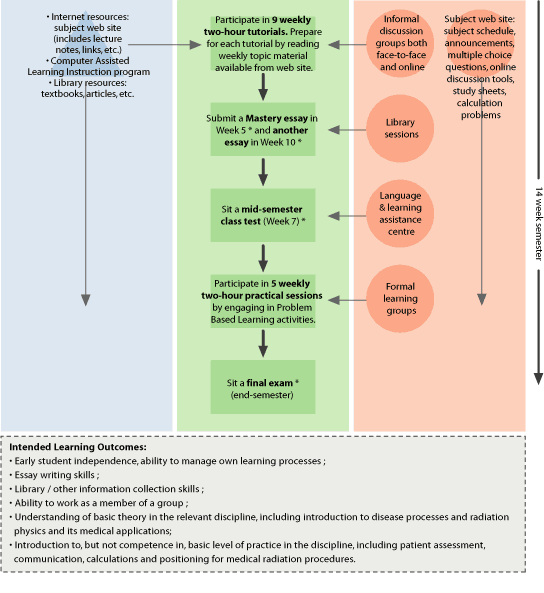| |
SUPPORTS SUPPLIED
Students are supported in a variety of ways:
Subject Web site:
The Web site supports students in their learning as it is
the central focus of the subject in that all the information
and resources about the subject plus online communication
tools to interact with other students are provided. This is
elaborated as follows:
- The web site has an Announcements page and a FAQ page
which students learn to use for communications very early
in the semester. The Announcements page is used for notices
from staff on things like change of tutorial rooms, reminders
about class tests, etc.
- The FAQ page is used by students for asynchronous communication.
They use it to pose questions of staff regarding subject
arrangements, etc., and to communicate with each other.
Although designed for one particular subject, students use
this page to discuss other first year subjects as well.
Discussion covers things like what material is to be covered
in a forthcoming class, when assessment dates might occur,
what students might have missed if they missed a class,
and more social aspects such as recruitment for the student
ball, etc. Staff also check this page, and will respond
if they see student misconceptions, etc. Students are very
helpful to each other, freely answering questions, even
if the answer is just "check the study guide".
- The web site also contains the study guide and assessment
details for the subject.
- Multiple choice questions are available on the web so
that students can test themselves. The questions provide
feedback for both incorrect and correct answers, and a score
after completion. The MCQs can be done as many times as
students wish.
Instructors:
There are three instructors/tutors assigned to small group
tutorials. They assist the students in the weekly tutorials
by facilitating group discussions, including giving students
opportunities to give oral presentations to the large group
and by providing a well-maintained subject web site. The three
lecturers check the FAQ site frequently and the first-year
coordinator checks it every day. When learning moves into
PBL, instructors have to help students acquire the skills
required. This includes providing detailed written support
materials and encouraging students to brainstorm a question,
rather than expecting an instant answer, as well as helping
them to develop the skills required to function well as a
group.
"External subject"support:
Library staff give two library orientation sessions. Access
to assistance with writing skills is needed because some students
will have poor writing skills. This is provided by a central
Faculty unit, the Language and Learning Assistance Centre.
The formative essay is an ideal tool for the identification
of students with writing difficulties.
Peer support:
Students can support each other by helping each other in the
informal tutorial groups and by meeting outside class hours
to share the research needed for addressing the PBL problems.
Students are very supportive of anyone who posts questions
to the FAQ site.
SIGNIFICANCE OF SUPPORT STRATEGIES
As this subject takes place in first semester, first year,
its support strategies are enormously important in easing
the school-to-university transition. By the end of the subject,
most students will have formed a supportive network of other
students, will have a good idea of the support systems in
place in the Faculty, and will feel more confident of their
independent learning ability. They will also have learnt basic
research and information retrieval skills.
SUPPORT STRATEGY ADAPTATION
Communications and student support in their learning groups
are the most critical forms of support.
Support such as help with finding relevant books, writing
skills, etc., could be gained in a different subject.
|
